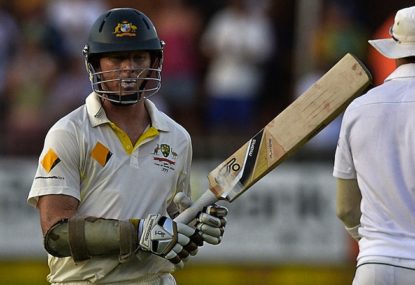Aussies leapfrog India in rankings despite neither team playing, Starc returns to form in IPL
Australia have reclaimed top spot in the ICC's Test rankings, replacing India. Despite not playing since winning 2-0 in New Zealand in March, Pat…

Underrated, under-appreciated and undervalued for much of his cricketing career, as well as the early days of his Test career, Chris Rogers will be dearly missed up the top of the Australian batting order.
I was, and still am, a huge fan of Rogers. A plucky, shortsighted redhead, hailing from the streets of St George, Rogers is the type of cricketer who should prove an inspiration for those wishing to become a professional cricketer.
Not a big hitter, or as attractive a cricketer as David Warner, Michael Clarke or Steve Smith, Rogers’ character is defined in one word that every cricketer should want to be recognised as – a fighter.
Since his selection in 2008, and subsequent dropping, Rogers was forced to watch other openers and less deserving cricketers get handed Test debuts due to their age, their ‘potential’, or simply because they were subject to state bias.
Yet Rogers kept batting, making huge scores for Western Australia, and a move to Victoria only increased his run flow, as his average reached beyond 50. This was also seen throughout his tenure in England, as county clubs such as Derbyshire, Leicestershire, Middlesex and Northamptonshire all benefitted from the incredible consistency Rogers possessed in his game.
Finally, after years of consistent run-making, Rogers was recalled to the Test squad for an Ashes birth, to face the likes of James Anderson, Graeme Swann and Stuart Broad.
However, even through his 25-match Test career, Rogers fought like hell to retain his place, with an unfair amount of scrutiny placed on his age and ability.
In tussles with the likes of Swann, Anderson, Dale Steyn, Morne Morkel, Yasir Shah and Ravichandran Ashwin, Rogers found himself facing the fearful prospect of being dropped if he put in a string of poor performances.
Struck on the head after the Phillip Hughes tragedy, concussed in the Caribbean and collapsing at Lord’s, all have symbolised Rogers’ career as a whole; a battle and a fight. Knocked down, but always back up again.
Often criticised for his inability to play spin, Rogers’ only true weakness seemed to be against the class of Swann, a man who troubled most world batsmen. He was only dismissed twice by spinners in the UAE against Pakistan, and played Moeen Ali the best out of all the Australian batsmen.
Just looking at the man, everything about Buck Rogers screams ‘battler’. From his arm and chest guards, to his ‘crab’-like technique and a mindset to make the bowler bowl at him, Rogers is a throwback to the yesteryears of cricket, an outsider to the ever-changing game of bigger bats, smaller boundaries and luxurious T20 contracts.
Rogers is a fighter, somebody that was unjustly unappreciated by the Australian cricketing community. Constantly looking to younger, more ‘attractive’ cricketers, Rogers’ airtight technique and rigid defence will be missed in a cricketing world epitomised by quick runs and fast-paced cricket.
His play in England, where he was named the Australian Player of the Series, was the reason to why Australian did not regularly get bowled out for scores under 100. The ability to leave the cricket ball is a skill that is greatly lacking in today’s game, and something that is being seen less and less with modern-day openers.
A great quote came out of the Ashes series of 2015, which compared the power of Warner to the patience of Rogers.
“When both openers play and miss, Warner is annoyed that he missed. Rogers is annoyed that he played.”
The partnership between the two was the most prolific opening partnership since the days of Matthew Hayden and Justin Langer. Polar opposites, Warner and Rogers put on over 100 nine times, with an average a tick over 50.
This, which will be sorely missed, has also seemed to benefit Warner, who has learnt from Rogers the art of patience. His two hundreds against New Zealand at the Gabba was evident of this, a patient and workman-like innings.
His protege, if you will, in Joe Burns, has a long way to go if he wishes to cement himself as Warner’s opening partner for the next 10 years, but his maiden Test ton was not a bad place to begin.
Rogers, his position in the team constantly under scrutiny, and criticised for his approach, ended his Test career with a remarkable record. In 25 matches, Rogers scored 2015 runs, at an average of 42.87, and a highest score of 173 at the Home of Cricket.
In the last three years, Rogers is third on the list of leading run scorers for Test openers, and his last eight matches yielded ten 50s, two of them 95s, and one of them a 173.
Now commentating on ABC Grandstand, and helping the Australian Under-19s, there is no man better to be giving fans an insight into the game, and coaching the next generation of Australian cricketers on how to leave the ball alone, how to defend, and most importantly, how to fight.
For the last two years, I have loved every minute of watching Chris Rogers bat. I rode with him, on his highs of scoring a century, lows of getting out early, or agony of being dismissed five runs short of a ton.
With the next generation of Australian cricket coming in, I will have to find a new cricketer to follow every step of the way.
We will miss you, Buck, thanks for the memories.